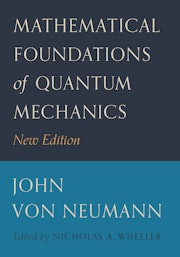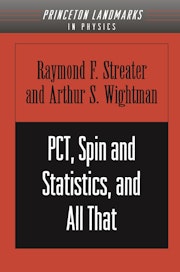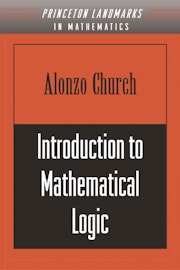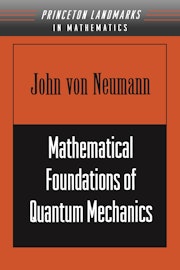Princeton Landmarks in Mathematics and Physics23
Committed to the highest standards of scholarship and to its widespread dissemination, av福利社 publishes a continuing series of paperback books in math and physics written by some of the world鈥檚 finest scientists on topics of lasting importance. These books will become indispensable additions to the personal libraries of advanced students, teaching faculty, and professional physicists and mathematicians.
-

A landmark work that belongs on the bookshelf of every researcher working with networks
-

Quantum mechanics was still in its infancy in 1932 when the young John von Neumann, who would go on to become one of the greatest mathematicians of the twentieth century, published Mathematical Foundations of Quantum Mechanics--a...
-

This book presents simple, elegant methods for dealing, both in theory and in application, with a variety of problems that have formulations in terms of flows in capacity-constrained networks. Since the theoretical considerations lead...
-

In the 1920s, when quantum mechanics was in its infancy, chemists and solid state physicists had little choice but to manipulate unwieldy equations to determine the properties of even the simplest molecules. When mathematicians turned...
-

This classic book is an introduction to dynamic programming, presented by the scientist who coined the term and developed the theory in its early stages. In Dynamic Programming, Richard E. Bellman introduces his groundbreaking theory...
-

In this classic work, Anthony W. Knapp offers a survey of representation theory of semisimple Lie groups in a way that reflects the spirit of the subject and corresponds to the natural learning process. This book is a model of...
-

For centuries, astronomers have been interested in the motions of the planets and in methods to calculate their orbits. Since Newton, mathematicians have been fascinated by the related N-body problem. They seek to find solutions to the...
-

PCT, Spin and Statistics, and All That is the classic summary of and introduction to the achievements of Axiomatic Quantum Field Theory. This theory gives precise mathematical responses to questions like: What is a quantized field? What...
-

This famous book was the first treatise on Lie groups in which a modern point of view was adopted systematically, namely, that a continuous group can be regarded as a global object. To develop this idea to its fullest extent, Chevalley...
-

When this book was written, methods of algebraic topology had caused revolutions in the world of pure algebra. To clarify the advances that had been made, Cartan and Eilenberg tried to unify the fields and to construct the framework of...
-

Fibre bundles, now an integral part of differential geometry, are also of great importance in modern physics--such as in gauge theory. This book, a succinct introduction to the subject by renown mathematician Norman Steenrod, was the...
-

Harald Cram茅r鈥檚 classic synthesis of statistical mathematical theory鈥攁n invaluable resource for students and practitioners alike
-

The influential book that established the mathematical discipline of linear programming
-

In his work on rings of operators in Hilbert space, John von Neumann discovered a new mathematical structure that resembled the lattice system Ln. In characterizing its properties, von Neumann founded the field of continuous geometry.
... -

In this, one of the first books to appear in English on the theory of numbers, the eminent mathematician Hermann Weyl explores fundamental concepts in arithmetic. The book begins with the definitions and properties of algebraic fields...
-

This elegant book by distinguished mathematician John Milnor, provides a clear and succinct introduction to one of the most important subjects in modern mathematics. Beginning with basic concepts such as diffeomorphisms and smooth...
-

In his classic work of geometry, Euclid focused on the properties of flat surfaces. In the age of exploration, mapmakers such as Mercator had to concern themselves with the properties of spherical surfaces. The study of curved surfaces...
-

In this renowned volume, Hermann Weyl discusses the symmetric, full linear, orthogonal, and symplectic groups and determines their different invariants and representations. Using basic concepts from algebra, he examines the various...
-

Available for the first time in paperback, R. Tyrrell Rockafellar's classic study presents readers with a coherent branch of nonlinear mathematical analysis that is especially suited to the study of optimization problems. Rockafellar's...
-

A classic account of mathematical logic from a pioneering giant in the field
-

Mathematical Foundations of Quantum Mechanics was a revolutionary book that caused a sea change in theoretical physics. Here, John von Neumann, one of the leading mathematicians of the twentieth century, shows that great insights in...
-

This book offers a concise introduction to the angular momentum, one of the most fundamental quantities in all of quantum mechanics. Beginning with the quantization of angular momentum, spin angular momentum, and the orbital angular...
-

Einstein's general theory of relativity requires a curved space for the description of the physical world. If one wishes to go beyond superficial discussions of the physical relations involved, one needs to set up precise equations for...